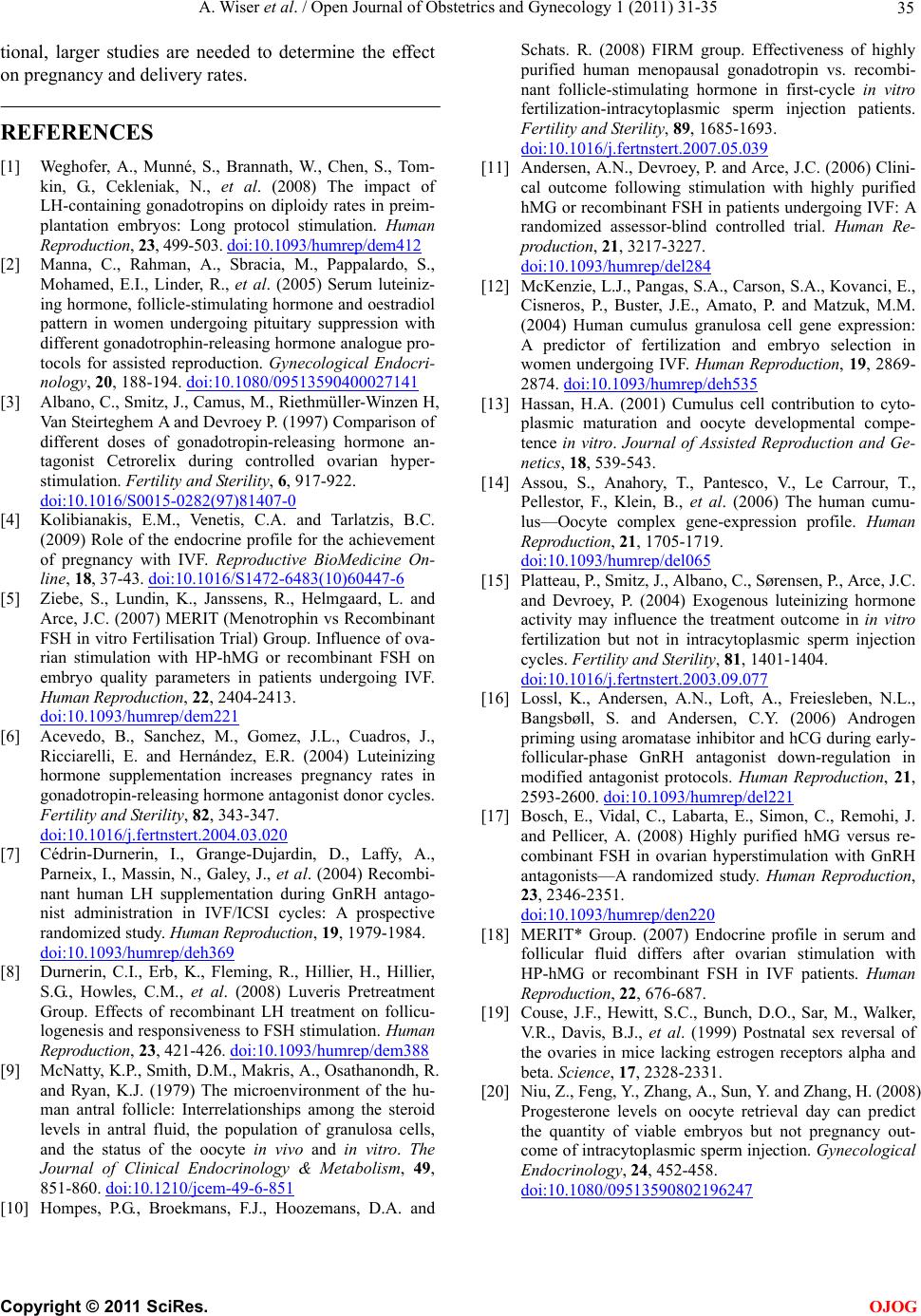
A. W iser et al. / Open Journal of Obstetrics and Gynecology 1 (2011) 31-35
Copyright © 2011 SciRes.
35
tional, larger studies are needed to determine the effect
on pregnancy and delivery rates.
OJOG
REFERENCES
[1] Weghofer, A., Munné, S., Brannath, W., Chen, S., Tom-
kin, G., Cekleniak, N., et al. (2008) The impact of
LH-containing gonadotropins on diploidy rates in preim-
plantation embryos: Long protocol stimulation. Human
Reproduction, 23, 499-503. doi:10.1093/humrep/dem412
[2] Manna, C., Rahman, A., Sbracia, M., Pappalardo, S.,
Mohamed, E.I., Linder, R., et al. (2005) Serum luteiniz-
ing hormone, follicle-stimulating hormone and oestradiol
pattern in women undergoing pituitary suppression with
different gonadotrophin-releasing hormone analogue pro-
tocols for assisted reproduction. Gynecological Endocri-
nology, 20, 188-194. doi:10.1080/09513590400027141
[3] Albano, C., Smitz, J. , Camus, M., Riethmüller-Winzen H,
Van Steirteghem A and Devroey P. (1997) Comparison of
different doses of gonadotropin-releasing hormone an-
tagonist Cetrorelix during controlled ovarian hyper-
stimulation. Fertility and Sterility, 6, 917-922.
doi:10.1016/S0015-0282(97)81407-0
[4] Kolibianakis, E.M., Venetis, C.A. and Tarlatzis, B.C.
(2009) Role of the endocrine profile for the achievement
of pregnancy with IVF. Reproductive BioMedicine On-
line, 18, 37-43. doi:10.1016/S1472-6483(10)60447-6
[5] Ziebe, S., Lundin, K., Janssens, R., Helmgaard, L. and
Arce, J.C. (2007) MERIT (Menotrophin vs Recombinant
FSH in vitro Fertilisation Trial) Group. Influence of ova-
rian stimulation with HP-hMG or recombinant FSH on
embryo quality parameters in patients undergoing IVF.
Human Reproduction, 22, 2404-2413.
doi:10.1093/humrep/dem221
[6] Acevedo, B., Sanchez, M., Gomez, J.L., Cuadros, J.,
Ricciarelli, E. and Hernández, E.R. (2004) Luteinizing
hormone supplementation increases pregnancy rates in
gonadotropin-releasing hormone antagonist donor cycles.
Fertility and Sterility, 82, 343-347.
doi:10.1016/j.fertnstert.2004.03.020
[7] Cédrin-Durnerin, I., Grange-Dujardin, D., Laffy, A.,
Parneix, I., Massin, N., Galey, J., et al. (2004) Recombi-
nant human LH supplementation during GnRH antago-
nist administration in IVF/ICSI cycles: A prospective
randomized study. Human Repr oduction, 19, 1979-1984.
doi:10.1093/humrep/deh369
[8] Durnerin, C.I., Erb, K., Fleming, R., Hillier, H., Hillier,
S.G., Howles, C.M., et al. (2008) Luveris Pretreatment
Group. Effects of recombinant LH treatment on follicu-
logenesis and responsiveness to FSH stimulation. Human
Reproduction, 23, 421-426. doi:10.1093/humrep/dem388
[9] McNatty, K.P., Smith, D.M., Makris, A., Osathanondh, R.
and Ryan, K.J. (1979) The microenvironment of the hu-
man antral follicle: Interrelationships among the steroid
levels in antral fluid, the population of granulosa cells,
and the status of the oocyte in vivo and in vitro. The
Journal of Clinical Endocrinology & Metabolism, 49,
851-860. doi:10.1210/jcem-49-6-851
[10] Hompes, P.G., Broekmans, F.J., Hoozemans, D.A. and
Schats. R. (2008) FIRM group. Effectiveness of highly
purified human menopausal gonadotropin vs. recombi-
nant follicle-stimulating hormone in first-cycle in vitro
fertilization-intracytoplasmic sperm injection patients.
Fertility and Sterility, 89, 1685-1693.
doi:10.1016/j.fertnstert.2007.05.039
[11] Andersen, A.N., Devroey, P. and Arce, J.C. (2006) Clini-
cal outcome following stimulation with highly purified
hMG or recombinant FSH in patients undergoing IVF: A
randomized assessor-blind controlled trial. Human Re-
production, 21, 3217-3227.
doi:10.1093/humrep/del284
[12] McKenzie, L.J., Panga s, S.A., Carson, S.A., Kovanci, E.,
Cisneros, P., Buster, J.E., Amato, P. and Matzuk, M.M.
(2004) Human cumulus granulosa cell gene expression:
A predictor of fertilization and embryo selection in
women undergoing IVF. Human Reproduction, 19, 2869-
2874. doi:10.1093/humrep/deh535
[13] Hassan, H.A. (2001) Cumulus cell contribution to cyto-
plasmic maturation and oocyte developmental compe-
tence in vitro. Journal of Assisted Reproduction and Ge-
netics, 18, 539-543.
[14] Assou, S., Anahory, T., Pantesco, V., Le Carrour, T.,
Pellestor, F., Klein, B., et al. (2006) The human cumu-
lus—Oocyte complex gene-expression profile. Human
Reproduction, 21, 1705-1719.
doi:10.1093/humrep/del065
[15] Platteau , P., Smitz , J., Albano, C., Sørensen, P., Arce, J.C.
and Devroey, P. (2004) Exogenous luteinizing hormone
activity may influence the treatment outcome in in vitro
fertilization but not in intracytoplasmic sperm injection
cycles. Fertility and Sterility, 81, 1401-1404.
doi:10.1016/j.fertnstert.2003.09.077
[16] Lossl, K., Andersen, A.N., Loft, A., Freiesleben, N.L.,
Bangsbøll, S. and Andersen, C.Y. (2006) Androgen
priming using aromatase inhibitor and hCG during early-
follicular-phase GnRH antagonist down-regulation in
modified antagonist protocols. Human Reproduction, 21,
2593-2600. doi:10.1093/humrep/del221
[17] Bosch, E., Vidal, C., Labarta, E., Simon, C., Remohi, J.
and Pellicer, A. (2008) Highly purified hMG versus re-
combinant FSH in ovarian hyperstimulation with GnRH
antagonists—A randomized study. Human Reproduction,
23, 2346-2351.
doi:10.1093/humrep/den220
[18] MERIT* Group. (2007) Endocrine profile in serum and
follicular fluid differs after ovarian stimulation with
HP-hMG or recombinant FSH in IVF patients. Human
Reproduction, 22, 676-687.
[19] Couse, J.F., Hewitt, S.C., Bunch, D.O., Sar, M., Walker,
V.R., Davis, B.J., et al. (1999) Postnatal sex reversal of
the ovaries in mice lacking estrogen receptors alpha and
beta. Science, 17, 2328-2331.
[20] Niu, Z. , Feng, Y., Zhang, A., Sun, Y. and Zhang, H. (2008)
Progesterone levels on oocyte retrieval day can predict
the quantity of viable embryos but not pregnancy out-
come of intracytoplasmic sperm injection. Gynecological
Endocrinology, 24, 452-458.
doi:10.1080/09513590802196247